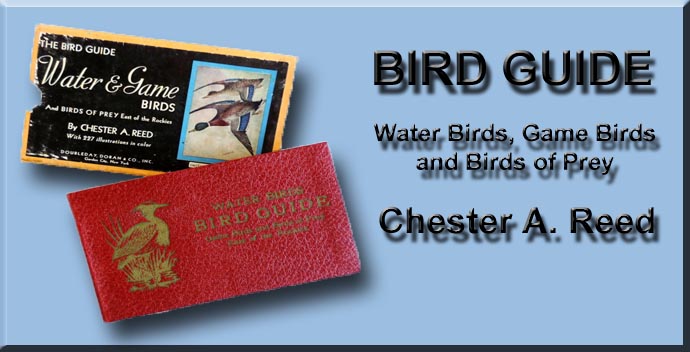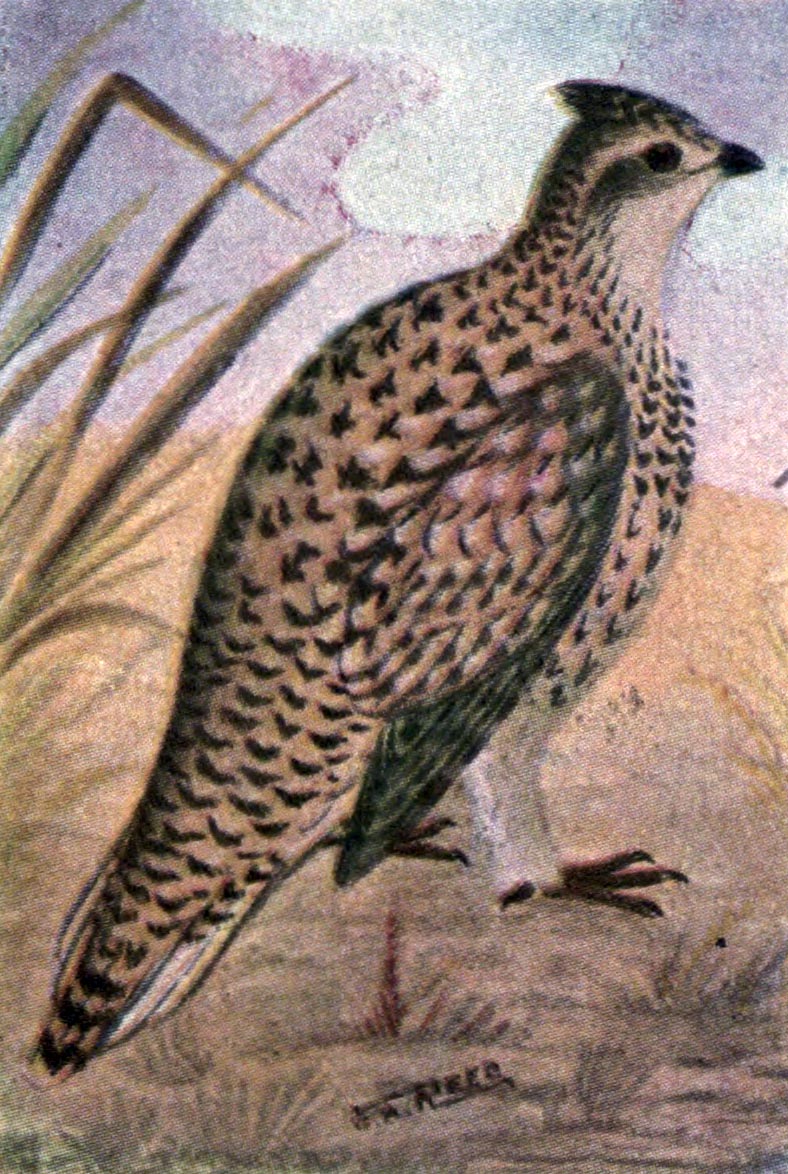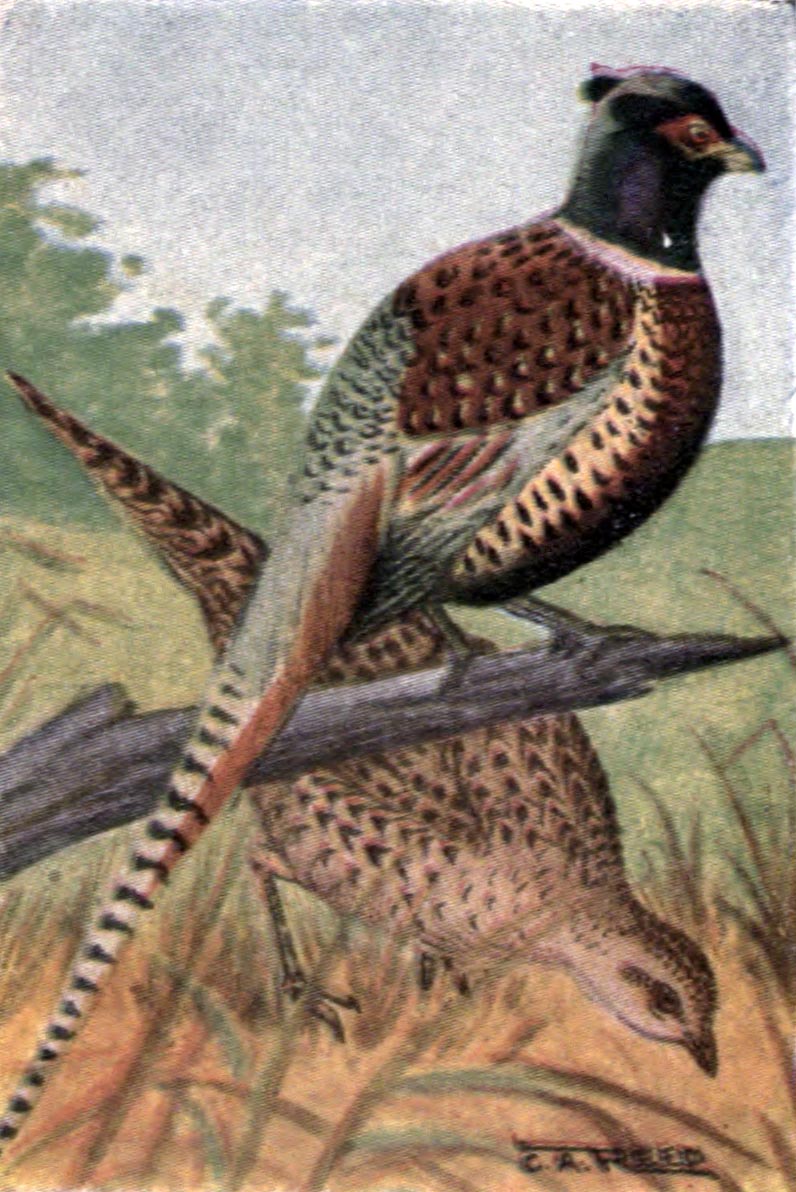
BIRD GUIDE
Water Birds, Game Birds and Birds of Prey
By Chester A. Reed
Order 10
GROUSE, PARTRIDGES, ETC.
Order Gallinę
|
|
||
Family Odontophoridę |
||
 |
BOB- WHITE; QUAIL; VIRGINIA PARTRIDGE289. Colinus mrginianus. 10 in. Male with white throat, bordered with black ; female with a yellowish-brown throat, and line above eye. One of the most popular " game birds," so popular that it is exterminated in New England, and birds imported from the west are unable to regain the lost foothold. Found in stubble and low brush, where they hide until almost stepped upon. They feed upon insects and grain. Notes. A clear whistled " bob- white " and a series of low, clear whistles when in flocks. Nest. Of grass at the end of tunnel in tall grass bordering fields; 8 to 16 white eggs (1.20 x. 95) ; May. Range. Resident east of the Rockies, north to Minn. and Ontario. 289a, Fla. Bob-white (C. v. floridanus ) , found in southern Florida is extremely dark (shown on plate). 289b, Texan Bob-white (C. v. texanus) is paler with black areas wider. |
|
|
|
||
SCALED PARTRIDGECallipepla squamata. 10 in. With a whitish or buffy-white crest; plumage bluish-gray, with darker edges giving the bird the appearance of being covered with scales. The female is more brownish, but is marked the same as the male. These birds are locally abundant in arid, cactus-covered deserts, often at a distance from water, and frequently in company with Gambel Partridge. Nest. 8 to 15 eggs are laid in some hollow under a low bush or cactus; they are creamy-white, dotted with minute specks of pale brown. ( 1.25 x. 95); April, May. Range. Mexico north to Central and Western Texas, New Mexico and Arizona. 293a. Chestnut-bellied Scaled Partridge (C. s. castanogastris), is more richly colored and has a chestnut patch on the middle of the belly. It is found in southern Texas and northeastern Mexico. |
 |
|
|
|
||
 |
GAMBEL PARTRIDGE295. Lophortyx gambclii. 10 in. Head with an elegant recurved crest of six or seven feathers; normally these are carried in one packet so that there appears to be but one feather, but when excited, or during the mating season, they may separate the feathers, or sometimes curve them forward so as to touch the bill. Hindhead and sides chestnut, throat and middle of belly black. Female with the throat light and hindhead gray; crest small; no black on belly. An abundant species both in mountains, valleys or deserts, near or remote from water. Habits like those of the eastern Bob-white, but instead of taking wing, they will generally run. Nest. Eggs laid on the ground under any suitable cover; creamy-white, handsomely blotched with brown. Range. Resident in western Texas, New Mexico and Arizona, north to southern Utah and Nevada. |
|
|
|
||
MEARNS OR MASSENA PARTRIDGE296. Cyrtonyx montezumę mcarnsi. 9 in. Bill very stout and compressed. Crest large, puffy and flat. 'Markings on the male very grotesque and clownish; general color of the female, pinkish brown with streaks of black, and white specks, below, and barred and streaked above. These strange birds are very local in their distribution in the southwest, rare in some localities and occurring in quite large flocks in others. They are so confiding in their disposition, that this, in connection with their clownish plumage, has given them the name of "Fool" Quail. They frequent dry deserts, valleys, or mountains up to an elevation of at* least 8,000 feet. When startled, they often squat down, and can almost^be caught in the hand, but when they do fly, their flight is very rapid, and accompanied with a peculiar clucking noise. Nest. A depression in the ground, lined with grasses, and concealed in clumps of weeds or grass. Their eggs, like those of other partridges, are numerous, pure white, and not as sharply pointed as those of the Bob-white. Range. Western Texas, New Mexico and Arizona. |
 |
|
|
|
||
 |
DUSKY GROUSE297. Dendragapus obscurus. 20 in. Plumage gray, white and black, with a few rusty markings on the back; wide gray band on tip of tail. Female smaller, browner and more barred above. These large grouse are found on side hills or in gulches, usually not far from water. Like our common Ruffed Grouse, during mating season, the males of this species strut about with tail fully spread over the back, and head thrown back until it nearly touches the tail. At this season they are very pugnacious and the woods will resound with their challenging " toots," loud and hollow sounds with a ventriloquial effect. Nest. Eggs laid on ground in woods, usually under fallen logs or at the bases of trees; buffy, sparsely spotted with brown. (2.00x1.40) ; May, June. Range. Rocky Mts., from Mexico to Montana and east to South Dakota. 297b., Richardson Grouse ( D. o. richardsonii) , is found on the eastern slopes of the Rockies, north to British America. Little or no band on the tail. |
|
|
|
||
HUDSONIAN SPRUCE GROUSE208. Canachites canadensis. 15 in. Very similar to the next, which is our common species, but the female is not quite as rusty. Found in Labrador and about Hudson Bay.
CANADA GROUSE; SPRUCE GROUSE298c. C. c. canace. 15 in. Male black and grayish; female chiefly rusty, barred with black. The Spruce Grouse is usually found in dense thickets and groves or swamps of evergreen woods. It is one of the least suspicious of birds, and in winter, is sometimes knocked down by sticks in the hands of deer hunters. Their flesh is unfit to eat and consequently they are not hunted. Notes. A drumming, said to be produced by the wings, when in the air; a clucking by the female. Nest. Eggs laid on the ground, usually under low, spreading branches of spruces; bright buff with bold black blotches. ( 1 .70 x 1 .25 ) . Range. Northern New England, New York and Minnesota, northward. |
 |
|
|
|
||
 |
RUFFED GROUSE300. Bonassa umbellus. 17 in. Crested and with two large, black, neck-ruffs; plumage brown, black and white. Female with the ruffs smaller and usually brownish. These grouse have two color phases, the general tone of plumage being either reddish brown or gray, independent of age or sex of bird. These naturally wild, shy grouse are the kings of the eastern game birds, their wariness and speed with which they will dodge through the trees being the only reasons they have so long withstood the hunting to which they are subjected. During spring, the male struts often, tail expanded into a half circle, head thrown back to meet the upturned tail, and ruff spread so as to form a complete collar. They make a loud drumming by beating the air with their wings. Nest. Eggs on leaves in the woods; plain brownish-buff (1.55x1.15). Range. Resident from Va. and Ark. north to southern Canada. 300a., Canadian Ruffed Grouse (B. u. togata), is found in the southern British provinces and northern New England. |
|
|
|
||
WILLOW PTARMIGAN301. Lagopus lagopus. 15 in. In winter, white with black tail feathers. In summer, usually reddish-brown with black bars. This species has a much stouter bill than the next. Nest. Eggs laid on the ground. Rich buffy, so heavily blotched and streaked with black as to nearly conceal it. (1.75x 1.25). Range. Breeds in the northern half of Canada, migrating southward to southern Canada. 301a., Allen Ptarmigan (L. l. alleni), found in Newfoundland, is similar, but in winter the shafts of the primaries are always black.
ROCK PTARMIGAN302. Lagopus rupestris. 14 in. In winter, like the last species, except that the bill is smaller, and the lores are black. Range. From the Gulf of St. Lawrence and northern British Columbia northward. 302a. Reinhardt Ptarmigan, replaces the last variety in northern Labrador. 303. Welch Ptarmigan ( L. welchi ) , found in New Foundland. is said to be grayer in summer. |
 |
|
|
|
||
 |
PRAIRIE HEN; PINNATED GROUSE305. Tympanuchus americanus. 18 in. Tufts of neck feathers rounded or square at the ends, long on the males, and short on the females. Above, barred with brownish-black and white or buffy white, the bars being of about equal width; top of head barred black and grayish. Female differs from the male in having the tail feathers barred, whereas they are black in the male. Found locally throughout the prairie regions of the Mississippi Valley north to Manitoba. Owing to the immense numbers shot for sale in eastern markets, they have become exterminated in many places where they were formerly abundant. Male birds have a loose sac or naked skin beneath the tufts of feathers on the neck; they inflate these to the size of small oranges, and then produce a loud, hollow, resonant booming sound. Nest. Anywhere on the ground on the prairie; eggs olive-buff, finely specked with brown. Range. From La. and Tex. north to Manitoba and Dakota. 305. Attwater Prairie Hen, smaller and darker, is found in Louisiana and Eastern Texas. |
|
|
|
||
HEATH HEN306. Tympanuchus cupido. 17 in. Neck feathers pointed; scapulars more broadly tipped with white; axillars always barred; top of head paler and always brownish. These differences will always separate this species from the very similar western bird. They were formerly found throughout Southern New England and the Middle States, their range meeting that of the Prairie Hen, but now they are restricted to the island of Martha's Vineyard, south of Mass., and probably the true form is extinct there, for western birds have been liberated on the island and interbred with the natives.
LESSER PRAIRIE HEN307. Tympanuchus pallidiciiictns. 16 in. Nearest like the prairie hen but paler above, the In-own bars being narrower and lighter colored, but with the edges blackish, giving the back of the bird a very different appearance from that of the Prairie Hen. "it is found in western Kansas, Indian Territory and Texas. |
 |
|
|
|
||
 |
PRAIRIE SHARP-TAILED GROUSE308b. Pedicecetes phasianellus campestris. 18 in. No pinnates or ruffs on the neck, but the head is crested a little more than that of the Prairie Hen; tail with the central feathers nearly two inches? longer than the rest, which are also graduated so the outside ones are much the shortest. Plumage much paler than that of the Prairie Hen, and feathers on the breast and sides being marked with blackish loops. Found in more or less abundance on the plains and prairies west of the Mississippi River. In mating season flocks of them indulge in curious antics, dancing, ruffling their feathers, and cooing and crowing. Nest. Eggs laid in a hollow in the ground, usually sheltered by a tuft of grass or bunch of weeds. The eggs are brownish-drab, finely specked, over the whole surface, with blackish-brown. ( 1.70 x 1.25 ). Range. West of the Miss. River, from New Mexico and Indian Territory north to Manitoba. 308. Sharp-tailed Grouse, is found in the interior of British America from Hudson Bay to Alaska. Darker and less rusty than the preceding. |
|
|
|
||
SAGE GROUSE309. Centrocercus urophasianus. 29 in. The female of this large and very interesting grouse, differs from the male only in its smaller size and paler, duller plumage. They are found in abundance on the dry sagebrush-covered plains about the Rocky Mts. and to the westward. In summer they feed largely upon insects and buds of various plants, but in fall and winter, their food is almost entirely the leaves of the sagebrush; at this season, in consequence, their flesh is unfit to eat, so they are not hunted for market, and are able to pursue a life of quiet as far as man is concerned. In spring, they indulge in amusing play, as do all the grouse; they have a few wiry hairs on either side of the neck, covering the naked sacs that correspond to those of the Prairie Hen; they strut about with these sacs inflated, and their spread tail, erect, making peculiar buzzing sounds. Nest. Eggs laid on the ground under sagebrush ; greenish-buff, spotted rather sparingly with brown. Range. Sagebrush covered plains from New Mexico to Southern British Columbia and Assiniboia |
 |
|
|
|
||
Family Meleagridę |
||
 |
WILD TURKEY310. Meleagres gallopavo silvestris. 48 in. Female much smaller and duller colored than the male. These fine, large birds frequent woodlands and borders of streams, where they search through the underbrush for food in the daytime and sleep in the tallest trees at night. They are one of the shyest birds, and they have reasons for being, for they have been hunted until there are none left in New England and northern Middle States. Wild Turkeys strut and gobble precisely like domestic ones. Their plumage is more of a coppery bronze color and their upper tail coverts are rusty, without white edges. Nest. Eggs laid on the ground among leaves, usually in dense thickets; buff, spotted with brown. (2.55 x1.90). Range. From Penn. and Ohio south to the Gulf States west to Arkansas. 310b., Florida Wild Turkey, found in Florida, is smaller. 310c., Rio Grande Turkey, is found in southern Texas; it has upper tail-coverts edged with buff. |
|
|
|
||
RING-NECKED OR MONGOLIAN PHEASANT*** Phasianus torquatus The male of this beautiful pheasant varies greatly in length according to the development of the tail, sometimes being 36 in. in length; the female averages about 22 in. and is plain colored, but still a very handsome bird. Males vary greatly in the richness of their colors, and in the width of the white collar on the neck, the latter depending upon the extent to which they have been interbred with the English Pheasant, the latter bird having no white on the neck. These pheasants have been introduced in Oregon and Washington and are very abundant there now. Attempts at introducing them in the East have not been as successful, but in some private preserves they are doing well. They are rather sluggish in their habits, compared to our Ruffed Grouse, and usually try to escape by running or hiding rather than by taking wing: when they do fly, they go in a straight line and rather slowly. |
 |
|
|
|
||
Family Cracidę |
||
 |
CHACHALACA311. Ortalis vetula mccalli. 21 in. Plumage olive-brown above, and gray below; head rested; sides of head and chin, naked, orange-red. Nest. A frail platform of sticks, placed in scrubby brush or bushes, a few feet above the ground. They lay four white or buffy-white eggs, the shell of which is very rough and hard (2.25x1.55); April. Range. Eastern Mexico north to southern Texas. |
|
 |
 |
|
|
|
-
Site Navigation
 Home
Home What's New
What's New Bible
Bible Photos
Photos Hiking
Hiking E-Books
E-Books Genealogy
Genealogy Profile
Free Plug-ins You May Need
Profile
Free Plug-ins You May Need
 Get Java
Get Java.png) Get Flash
Get Flash Get 7-Zip
Get 7-Zip Get Acrobat Reader
Get Acrobat Reader Get TheWORD
Get TheWORD